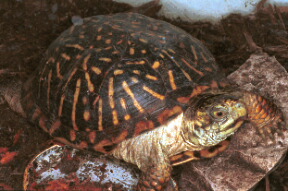|
|
|


Size/Growth: The average adult size of ornate box turtles are 4 to 5 inches. Hatchling box turtles, which are 1 1/8 to 1 1/4 inches when born, take approximately four to six years to reach adult size. How fast baby box turtles grow depends on the conditions in which the animals are raised like: diet, temperature and hibernation.
Distribution: The ornate box turtle is found in woody grassland and prairie areas in the central to south central United States. Another similar turtle is the desert box turtle (Terrapene ornata luteola); this species is found in the most southern tips of the United States and NE Mexico.
Captive Environment: The ornate box turtle is not recommended for beginners. The species is very sensitive to environmental change and is hard to keep successfully in captivity. Box turtles can be kept in either indoor or outdoor enclosures. For those who live in colder parts of the world both, indoor and outdoor enclosures are used. Ornate box turtles are found in woody grassland and prairie areas where the top soil is dry yet underneath it is moist and humid. These habitats usually have a body water in which the turtles can retreat to for drinking. The turtles don't really swim but, they love to soak in order to rehydrate themselves, as well as to leave waste. These terrestrial turtles spend half of their time simply hiding under logs or in burrows. High day time temperatures force the turtles to their burrows during the hottest part of the day. These box turtles seem to be most active at dawn and late afternoon to dusk, and during and just after a rain storm.
Creating an environment, in captivity, to replicate the turtles natural habitat is very important for the well being of the turtle. Providing 4 inches of moist (not wet) soil mixed with peat moss and/or finely ground orchid bark. This type of substrate is essential for burrowing. Mixing the substrate with sand may ware down the shell of the turtle and even create bacterial infections by leaving abrasions in the skin. The turtle will need a place to retreat to like a half log or a bundle of straw. These retreat places are considered micro-environments; which are sub-environments for the animal to help it maintain proper hydration through higher relative humidity, such as in burrows. A shallow pan of clean water should be available at all times for the turtle to soak in. It's a good idea to mist the turtle's environment down every morning for proper humidity levels.
Diet: The diet of these box turtles should consist of 50% insect protein, 35% plant matter and 15% fruits. Ornate box turtles are highly carnivorous and should be offered many different sources of protein that are lightly dusted with vitamin/mineral supplements.
www.americanboxturtle.freeservers.com